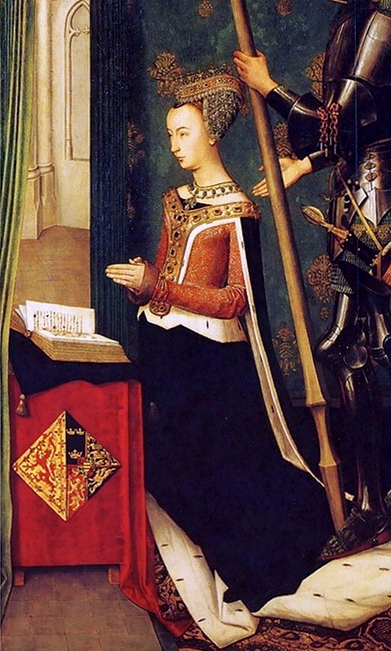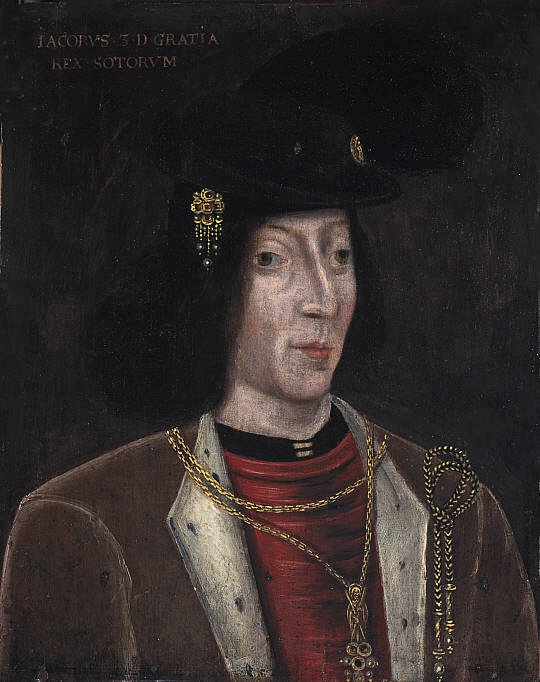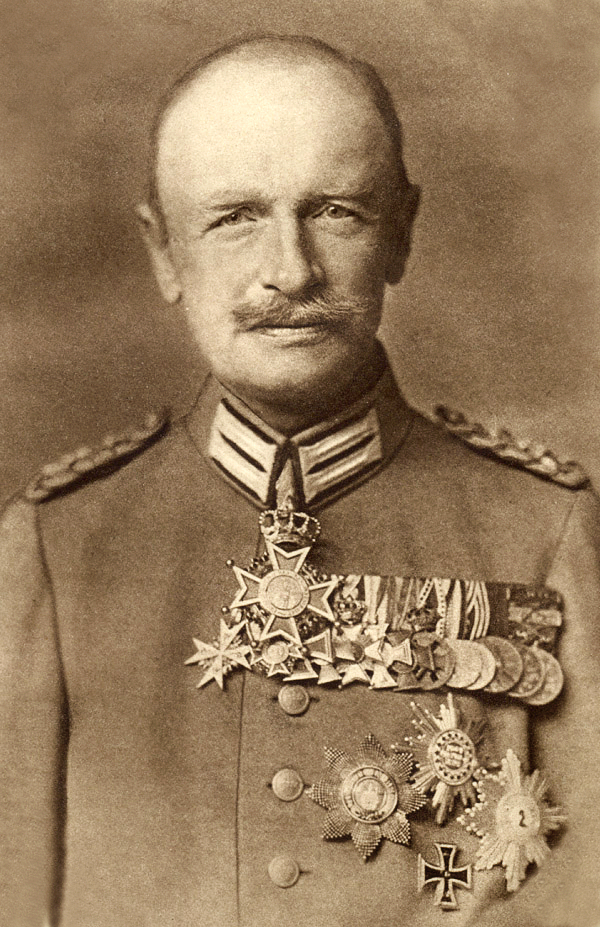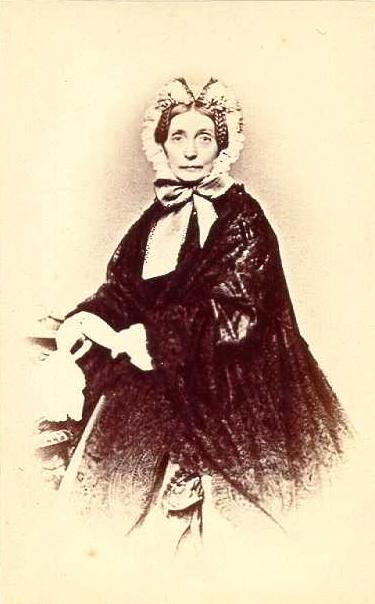by Susan Flantzer
© Unofficial Royalty 2017
Crown Prince Haakon of Norway and Mette-Marit Tjessem Høiby were married on August 25, 2001, at the Oslo Cathedral in Oslo, Norway.
Haakon’s Early Life
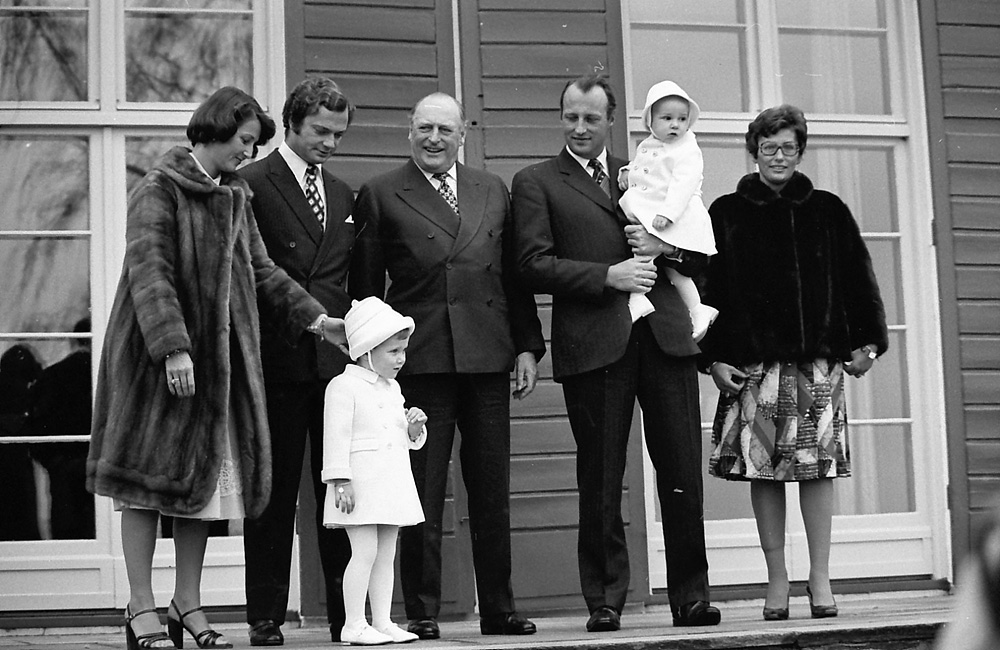
Left to right: Crown Princess Sonja of Norway, King Carl XVI Gustav of Sweden, Princess Märtha Louise of Norway, King Olav V of Norway, Crown Prince Harald holding Prince Haakon and Princess Astrid of Norway, 1974; Photo Credit – Wikipedia
Crown Prince Haakon Magnus of Norway was born on July 20, 1973, at the Rikshospitalet in Oslo, Norway. Haakon is the son of King Harald V and Sonja Haraldsen and has an older sister, Princess Märtha Louise. He was born during the reign of his grandfather, King Olav V of Norway.
Haakon was raised at the Skaugum Estate in Asker, which is the traditional home of the Crown Prince, and attended primary and secondary school in Oslo. He enrolled in the Royal Norwegian Naval Academy, graduating in 1995. The following year, he moved to the United States to attend the University of California at Berkeley, graduating in 1999 with his Bachelor’s Degree in Political Science. He served as a member of Norway’s third delegation to the United Nations General Assembly in 2000 and then enrolled in a program for diplomats at the Foreign Ministry. He completed his education in 2003, graduating from the London School of Economics and Political Science with a Master’s Degree in development studies, specializing in International Trade and Africa.
Mette-Marit’s Early Life

Mette-Marit as a child; Photo Credit – http://www.adressa.no
Mette-Marit Tjessem Høiby was born August 19, 1973, in Kristiansand, Norway, the daughter of Sven Høiby, a journalist, and Marit Tjessem. Mette-Marit has an older sister Kristin and two older brothers, Espen and Per. Her parents divorced when she was 11 years old and they both remarried. After her parents’ divorce, Mette-Marit lived with her mother, stepfather, and siblings and visited her father regularly on weekends.
Mette-Marit attended secondary school in Kristiansand and Australia, followed by some courses at Agder University College. After her marriage, Mette-Marit studied for a Masters Degree in Executive Management which she received in 2012. She has a son from a previous relationship, Marius Borg Høiby, born in 1997.
The Engagement
Crown Prince Haakon and Mette-Marit first met in the mid-1990s at a garden party during the Quart Festival, Norway’s largest music festival, in her hometown of Kristiansand. The two met at the Quart Festival again in 1999 and began a relationship. On December 1, 2000, the couple’s engagement was announced, but it was not without controversy. Mette-Marit was a commoner, had a child born out of wedlock, and was surrounded by rumors of a party-girl past and alleged drug use. The couple was living together which did not sit well with the Church of Norway. Surveys at that time reported that most Norwegians did not mind the couple living together or that she was a single mother. However, public support for the monarchy suffered as the details emerged about Mette-Marit’s drug past and there were calls for Haakon to relinquish his place in succession if he chose to marry Mette-Marit. The couple did, however, have the support of the King and Queen, and after a series of public interviews, they also regained the support of the Norwegian people.
The diamond and ruby ring that Haakon gave to Mette-Marit originally belonged to his paternal grandmother Crown Princess Märtha, who died before her husband became King Olav V. It was the same ring Haakon’s father King Harald V gave to his fiancée Sonja Haraldsen. Queen Sonja continued the tradition, giving the ring to her son when he proposed to Mette-Marit. The ring was composed of diamonds and two crescent-shaped rubies set in yellow gold.

The engagement ring; Photo Credit – http://lovelolaheart.com
Pre-Wedding Festivities
At the private party at the Skaugum Estate: Bridesmaid Linda Tånevik, Queen Sonja, Crown Prince Haakon, King Harald, and Princess Märtha Louise
On August 23, 2001, Crown Prince Haakon and Mette-Marit Tjessem Høiby held a private party at the Skaugum Estate in Asker near Oslo attended by many royal guests. King Harald gave the estate as a wedding gift to his son Haakon, and his soon-to-be wife Mette-Marit, and the estate became their family home.
Guests on the boat trip around the Oslo Fjord: Máxima Zorreguieta, Crown Prince Willem-Alexander of the Netherlands; Sophie, Countess of Wessex and Princess Märtha Louise of Norway
In the afternoon of August 24, 2001, Haakon and Mette-Marit invited royal, Norwegian, and foreign guests for a boat trip around the Oslo Fjord on the Royal Yacht Norge. Later in the evening, the Norwegian government held a dinner for the bride and groom at the Akershus Castle in Oslo attended by 300 guests including many royal guests, heads of state, and Norwegian politicians.
The Wedding Guests
Approximately 800 guests attended the wedding ceremony at Oslo Cathedral.
King Harald and Queen Sonja, the groom’s parents, arrive for the wedding
Crown Prince Haakon’s Family
- King Harald V and Queen Sonja of Norway, parents of the groom
- Princess Märtha Louise of Norway, sister of the groom
- Princess Ragnhild, Mrs. Lorentzen and Erling S. Lorentzen, aunt and uncle of the groom
- Princess Astrid, Mrs. Ferner and Johan Martin Ferner, aunt and uncle of the groom
Mette-Marit Tjessem Høiby’s Family
- Marit Tjessem and Rolf Berntsen, mother of the bride and her second husband
- Sven O. Høiby, father of the bride and his partner Jorunn Wold who was a singing star in the 1960s
- Espen Høiby and Hege Skatvig Høiby, brother of the bride and his wife
- Per Høiby and Wenche Lindal Høiby, brother of the bride and his wife
- Kristin Høiby Bjørnøy and Per Olav Bjørnøy, sister of the bride and her husband
Crown Princess Victoria of Sweden arrives with her siblings Prince Carl Philip and Princess Madeleine
Royal Guests
- King Albert II and Queen Paola of the Belgians
- Prince Philippe of Belgium, Duke of Brabant
- Queen Margrethe II of Denmark
- Crown Prince Frederik of Denmark
- Prince Joachim and Princess Alexandra of Denmark
- Princess Benedikte of Denmark and Prince Richard zu Sayn-Wittgenstein-Berleburg
- Princess Alexandra zu Sayn-Wittgenstein-Berleburg and Count Jefferson-Friedrich von Pfeil und Klein-Ellguth
- Hereditary Prince Gustav zu Sayn-Wittgenstein-Berleburg
- Princess Nathalie zu Sayn-Wittgenstein-Berleburg
- Count Flemming and Countess Ruth of Rosenborg
- King Constantine II and Queen Anne-Marie of Greece
- Princess Alexia of Greece and Carlos Morales Quintana
- Prince Nikolaos of Greece
- Grand Duke Henri and Grand Duchess Maria Teresa of Luxembourg
- Hereditary Grand Duke Guillaume of Luxembourg
- Grand Duke Jean and Grand Duchess Joséphine-Charlotte of Luxembourg
- Prince Guillaume and Princess Sibilla of Luxembourg
- Willem-Alexander, The Prince of Orange and his fiancée Máxima Zorreguieta
- Hereditary Prince Albert of Monaco
- Prince Constantijn and Princess Laurentien of the Netherlands
- Queen Sofia of Spain
- Felipe, Prince of Asturias
- King Carl XVI Gustaf and Queen Silvia of Sweden
- Crown Princess Victoria of Sweden
- Prince Carl Philip of Sweden
- Princess Madeleine of Sweden
- Prince Carl and Princess Kristine Bernadotte
- The Prince of Wales
- The Earl and Countess of Wessex
Other guests
- President Ólafur Ragnar Grimsson of Iceland and his fiancée Dorrit Moussaieff
- President Tarja Halonen of Finland and her husband Pentti Arajärvi
The Wedding Attendants

http://nrk.no/nyheter
Best Man
- Crown Prince Frederik of Denmark, third cousin and friend of the groom
The Best Man, Crown Prince Frederik of Denmark on left, waits for the bride’s arrival with the groom
Bridesmaid
- Linda Tånevik, a close friend of the bride

Bridesmaid Linda Tånevik assists the bride as she enters the cathedral with her groom; Photo Credit – http://www.seher.no/
Flower Girls
- Betina Swanstrøm, age 8, twin of Emilie, daughter of Queen Sonja’s nephew Dag Swanstrøm
- Emilie Swanstrøm, age 8, twin of Betina, daughter of Queen Sonja’s nephew Dag Swanstrøm
- Kamilla Bjørnhøy, age 12, niece of the bride
- Anniken Bjørnhøy, age 7, niece of the bride
- Tuva Høiby, age 4, niece of the bride
Marius Borg Høiby, the bride’s son
Pageboy
- Marius Borg Høiby, age 4, son of the bride
The Wedding Attire
Mette-Marit’s wedding gown was designed by the Norwegian designer Ove Harder Finseth and sewn by seamstress Anna Bratland. The gown was a simple and romantic full-length ecru-colored silk crepe dress with fitted long sleeves, a modest neckline, a corset waist and a 6 1/2 foot/2 meter train. The gown was nearly a replica of the dress Queen Maud, Prince Haakon’s great-grandmother, wore at her wedding to King Haakon VII.
The bride’s hair was pulled back in a simple chignon. Mette-Marit wore a 20 foot/6 meter long veil of silk tulle and a diamond tiara dating back to 1910, a gift from King Harald and Queen Sonja. Instead of a traditional bouquet, Mette-Marit carried a long garland of green leaves woven with purple and white flowers, also similar to the bouquet Queen Maud carried on her wedding day.
Crown Prince Haakon wore the gala uniform of the Norwegian Army with the sash of the Grand Cross of the Royal Norwegian Order of St. Olav with Atar, the star of the Swedish Order of the Seraphim and the Star of the Danish Order of the Elephant. Around his neck, he wore the Royal Norwegian Order of Merit.
The Crown Prince wore the following medals:
- The Knight’s Cross of the Royal Norwegian Order of St. Olav
- The Knight’s Cross of the Royal Norwegian Order of Merit
- The Defence Service Medal with Laurel Branch
- Olav V’s Commemorative Medal
- Olav V’s Jubilee Medal
- The National Service Medal (Navy)
The Wedding Ceremony
The Lutheran wedding ceremony was held on August 25, 2001, at 5:00 pm in the Oslo Cathedral (Oslo-Dom), the main church for the Church of Norway Diocese of Oslo, and conducted by Gunnar Stålsett, Bishop of Oslo.
The music was provided by:
- Organist: Kåre Nordstoga
- Choir: Oslo Dom-Choir, conductor Terje Kvam
- Trumpets: Arnulf Naur Nilsen, Jonas Haltida, Hans Petter Stangnes and Terje Mitgård
- Trombones: Thorbjørn Lønmo and Ola Rønnow
- Tuba: Arild Ovrum
Order of service
- Introductory organ music by L.M. Lindeman, Oscar Borg, J. Haarklou and J. G. Wernicke
- Entrance – Bridal March, Composer: Nils Henrik Aasheim
- Psalm, Norwegian Psalmbook nr. 698
- Introductory speech
- God’s word about marriage
- Jan Garbarek, Norwegian jazz musician, plays «Eg vil binda blomekransa» on his saxophone
- Speech by the Bishop
- Exchanging of the vows
- Mari Boine sings «Mitt hjerte alltid vanker» (My heart always wanders) in the Samish language, the language of Sami people, the indigenous people traditionally known in English as Lapps or Laplanders, accompanied by Roger Ludvigsen on guitar
- Reading from Isaiah, chapter 58, verse 5-8 by Princess Märtha Louise of Norway
- The Lord’s Prayer
- Psalm, Norwegian Psalmbook nr.710
- Crown Princess Victoria reads the prayer of Francis of Assisi (in Swedish)
- Choir: Versikkel for choir and organ, Composer: Trond Kverno
- Psalm, Norwegian Psalmbook nr. 733
- Blessings
- Departure: Utmars Gamal wedding march from northern Gudbrandsdal, performed and arranged for saxophone by Jan Garbarek, arrangement for organ by Kåre Nordstoga
Breaking with tradition, Haakon did not wait for his bride at the altar. Instead, he waited outside the door of the church because Mette-Marit wanted to walk down the aisle alongside Haakon instead of on her father’s arm. After bowing to Haakon’s parents, the couple took their seats and the Bishop of Oslo welcomed not just the guests in the cathedral but also the Norwegian people. During his speech, Bishop Stålsett moved Mette-Marit to tears when he said, “You are beginning a new chapter, with pages still unwritten. You do this with dignity. Today you are better equipped to understand others, young and old, who are in pain. Your love for your son shows both tenderness and determination. As a single mother, you have set an example in the way you have cared for your child.”

Photo Credit – http://www.seher.no
Tears could be seen on Haakon’s face just before he had to say “I do” to Mette-Marit and slip the wedding band onto her finger. When he finally did say, “I do,” the crowd outside the cathedral cheered. The newlyweds left the cathedral around 5:55 p.m. They kissed several times In front of the cathedral, watched by a very enthusiastic crowd. Then the couple left in an open limousine and drove back to the Royal Palace, slowly passing thousands of cheering people along the route.
The Wedding Reception
At 6:45 pm, Haakon and Mette-Marit appeared on the balcony of the Royal Palace, and to the delight of the thousands of people in the square below, they kissed each other several times. Also appearing on the balcony were the parents of the couple and the wedding party.
Four hundred guests were divided into two groups: the royal guests had dinner with other important guests at the Royal Palace while the others ate at the Oslo Militære Samfund (Oslo Military Society). After dinner, the guests at the Oslo Militære Samfund joined the other guests at the Royal Palace.
At 11:00 pm, the bride, groom, and their families appeared on the balcony of the Royal Palace to watch the fireworks. The other guests watched from the windows of the Royal Palace. At 11:15 pm, Haakon and Mette-Marit cut the wedding cake and then they opened the ball with the bridal waltz, “Around the World.”
Menu
- Grilled scallops on Norwegian bacon
- Truffle honey vinaigrette
- Rucola salad and toasted pumpkin seeds
- Peregrine pie
- Oven-baked turbot with soy and ginger
- Cauliflower purée sprinkled with finely chopped chives
- Lamb fillet and creamy cantaloupe
- Baked mini-squash
- Snowy yogurt ice parfait with raspberry, blueberries, and blackberries
The Honeymoon
Haakon and Mette-Marit spent their honeymoon in the United States and they were in the USA on September 11, 2001, when a series of four coordinated terrorist attacks with airplanes by Islamic terrorists occurred. The couple had left for the United States shortly after their wedding but fortunately were not in New York City at the time of the attacks on the World Trade Center. Haakon and Mette-Marit had spent time in New York City with Mette-Marit’s son Marius and were photographed in a Manhattan sidewalk café on August 29. Then they went to stay at Gurney’s Inn, a luxury spa-hotel in Montauk, New York on Long Island, just over 100 miles outside of New York City. It was at Gurney’s Inn that they first heard the news about the terrorist attacks. Haakon and Mette-Marit, along with thousands of other dazed, shocked, and stranded travelers (including the author of this article), waited several days until the United States opened its airports and allowed air travel to resume.
This article is the intellectual property of Unofficial Royalty and is NOT TO BE COPIED, EDITED, OR POSTED IN ANY FORM ON ANOTHER WEBSITE under any circumstances. It is permissible to use a link that directs to Unofficial Royalty.
Works Cited
- En.wikipedia.org. Wedding of Haakon, Crown Prince of Norway, and Mette-Marit Tjessem Høiby. [online] Available at: https://en.wikipedia.org/wiki/Wedding_of_Haakon,_Crown_Prince_of_Norway,_and_Mette-Marit_Tjessem_H%C3%B8iby [Accessed 2 Jul. 2017].
- Gibbs, W. Uncommon Royal Couple Exchange Vows in Norway. [online] Nytimes.com. Available at: http://www.nytimes.com/2001/08/26/world/uncommon-royal-couple-exchange-vows-in-norway.html [Accessed 2 Jul. 2017].
- Hoge, W. (2017). Norway’s Thoroughly Modern Royal Pair. [online] Nytimes.com. Available at: http://www.nytimes.com/2001/03/05/world/norway-s-thoroughly-modern-royal-pair.html [Accessed 2 Jul. 2017].
- Kongehuset.no. Kongeleg bryllaup 2001. [online] Available at: http://www.kongehuset.no/artikkel.html?tid=29240 [Accessed 2 Jul. 2017].
- Nettyroyal.nl. Netty Royal. [online] Available at: http://www.nettyroyal.nl/en/non_pro/specials_weddings_2001_haakon_mettemarit.html [Accessed 2 Jul. 2017].
- Unofficial Royalty. Crown Prince Haakon of Norway. [online] Available at: https://www.unofficialroyalty.com/crown-prince-haakon-of-norway/ [Accessed 2 Jul. 2017].
- Unofficial Royalty. Crown Princess Mette-Marit of Norway. [online] Available at: https://www.unofficialroyalty.com/featured-royal-date-august-19-1973-birth-of-mette-marit-tjessem-hoiby-crown-princess-of-norway/ [Accessed 2 Jul. 2017].
- Us.hellomagazine.com. A MODERN FAIRYTALE AS CROWN PRINCE HAAKON MARRIES HIS METTE-MARIT. [online] Available at: http://us.hellomagazine.com/royalty/2001/08/25/norwegianmarriage/ [Accessed 2 Jul. 2017].
- Us.hellomagazine.com. PRINCE HAAKON AND HIS BRIDE WELCOMED HOME AFTER HONEYMOON IN U.S.. [online] Available at: http://us.hellomagazine.com/royalty/2001/09/18/haakon/ [Accessed 2 Jul. 2017].
